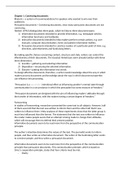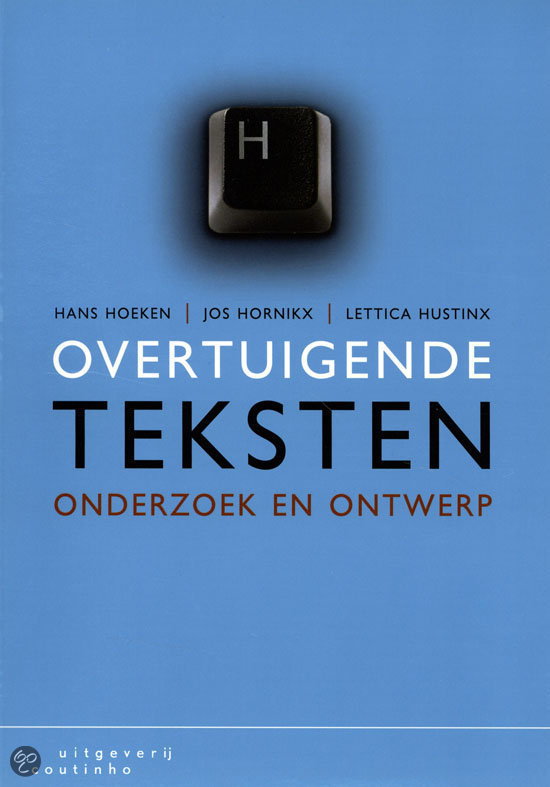Chapter 1. Convincing documents
Rhetoric = a system of recommendations for speakers who wanted to win over their
audiences.
Persuasive documents > Convincing documents, since many persuasive documents are not
convincing.
Hoeken (1992) distinguishes three goals, which he links to three document types:
1) Informative documents intended to provide information, e.g. newspaper articles,
information brochures and textbooks.
2) Instructive documents intended to help readers perform certain actions, e.g. user
manuals, computer documentation, forms and patient information leaflets.
3) Persuasive documents intended to convince readers of a particular point of view, e.g.
directives, advertisements and fundraising letters.
By making specific choices concerning content, structure and style, writers can control the
effectiveness of their documents. The classical rhetoricians were already familiar with these
three dimensions:
1) Inventio = gathering and selecting information.
2) Disposition = structuring the selected information.
3) Elocutio = putting the information into words.
To design effective documents, therefore, a writer needs knowledge about the way in which
readers process documents and knowledge about the way in which document properties
can influence this processing.
“Persuasion is a successful, intentional effort at influencing another’s mental state through
communication in a circumstance in which the persuadee has some measure of freedom.”
“Persuasive documents are designed with the aim of influencing readers’ attitudes through
the transfer of information, with the readers having a certain degree of freedom.”
Forewarning
In studies of forewarning, researchers presented the same text to all subjects. However, half
of them was told that the text was written to inform them and the other half that it was
written to influence them. Meta-analyses of these experiments show that the latter group is
much less influenced than the former. The statement that the text was written to influence
the reader makes people aware that an attempt is being made to change their attitudes,
which will encourage them to defend their present position.
Informative documents seem to be read more from the perspective of the communication
principle.
The author’s intention determines the nature of the text. The journalist wants to inform
people, and thus writes an informative document. The writer of the fundraising letter wants
to convince people, and thus writes a persuasive document.
Informative documents seem to be read more from the perspective of the communication
principle than persuasive documents. This communication principle, which is based on
Grice’s cooperation principle, states that four criteria must be met:
- Clarity
, - Honesty
- Efficiency
- Relevance
Directive communication Intention to make the target group draw a particular conclusion.
Non-directive communication No intention to steer people towards a particular
conclusion. The target group is left to make up their own mind.
Persuasive communication is aimed at influencing people’s attitudes. Such attempts often
have an underlying goal: influencing people’s behaviour.
The government can choose between several instruments, based on the nature of the
situation:
1) Measurability of the behaviour
The measurability or knowability of the behaviour is the ease – or difficulty – with which the
government can monitor whether people abide by the rules. The easier it is to ascertain that
people do so, the lower the enforcement burden. It is impossible for the government, for
instance, to check whether smokers have indeed stopped smoking in the house.
2) Structure of the target group
Is this group small and easy to identify or large and heterogenous? This dimension also has
an effect on the enforcement burden. If the group is small and easy to identify, the
enforcement burden will be light.
3) Costs for the target group
Does the new behaviour lead to higher costs for the target group, or to less comfort? The
higher the people perceive costs to be, the less they will be inclined to adopt the desired
behaviour.
Dimension 1 Direct regulation
Dimension 2 Direct regulation
Dimension 3 Social regulation
Noar (2006) believes that the chance of a successful campaign is highest if the following
seven steps are taken:
1) Conducting formative research
Before the campaign starts, conduct research to identify the determinants of the target
behaviour and the conditions under which this behaviour is exhibited. It is also important to
pretest the specific messages in the target group to determine their suitability and
effectiveness.
2) Using theory
Theories and models can give direction to decisions concerning the messages and the target
group and the ways in which the messages should be delivered to the target group.
3) Segmenting the target group
Divide the target group into subgroups, each of which should be reached in a similar manner
and/or through similar channels.
4) Using an appropriate message design
Develop new and creative messages that the members of the target group will talk about.
5) Choosing appropriate channels
,Choose media and channels that have wide reach across the target group.
6) Controlling the process
Conduct research during the campaign to see whether the choices made concerning target
group, message and channels have the desired effect.
7) Conduct good evaluation research
The designer of a message must make choices concerning its properties:
- Content
- Structure
- Style
- Illustrations
A good persuasive document is tailored to the properties of its readers. When designing a
document, the way in which readers process it must be taken into account.
“How do document properties influence the persuasion process?”
Research into the influence of message properties often has limitations.
The presence of an effect in one situation is no guarantee that this effect will occur
again in a slightly different situation.
Research into written documents cannot be applied one on one to communication
via other modalities.
It is not the document which ensures that other properties are relevant. It is the properties
of the context, such as how interested readers are in the subject or what they know about it,
that determine on which document properties they will base their judgement.
, Lecture 1. Influencing behaviour
How to get people to do something:
No freedom (threat of violence)
Very limited freedom (legal provisions)
Considerable freedom (transfer of information)
What is persuasion?
“Successful intentional effort at influencing another’s mental state through communication
in a circumstance in which the persuadee has some measure of freedom.”
Functions of documents:
1) Informative documents, e.g. leaflets on Melanoma. ≠ Persuasion
2) Instructive documents, e.g. explanation on a product. ≠ Persuasion
3) Persuasive documents, e.g. asking for a donation.
A persuasive document can be text or a poster, conveyed through humour or through
sharing joint values.
Our goal for this course is to understand how persuasion communication processes work so
we can intentionally influence people’s behaviour by purposefully and meaningfully applying
theory on persuasive communication in an evidence-based way.
Persuasion communication process (simplified)
Sender Document Receiver
Goal: persuasion Properties: content, structure, Processing effects
style, illustrations of document
properties
What are the properties of a persuasive document?
How does a typical receiver perceive the persuasion?
Fit our goals.
Become aware how they’re processed.
Consider receiver’s knowledge of persuasion goal.
“Successful intentional effort at influencing another’s mental state through communication
in a circumstance in which the persuadee has some measure of freedom.”
Attitude = a psychological tendency that is expressed by evaluating a particular entity with
some degree of favour or disfavour. (= particular disposition)
Attitude change precedes behaviour change! In order to achieve behavioural change, we
need to achieve attitude change first.
Communication as panacea?
“Do not park bicycles here!”
“No smoking!”
Legislation versus Communication
Dutch Scientific Council for Government Policy





